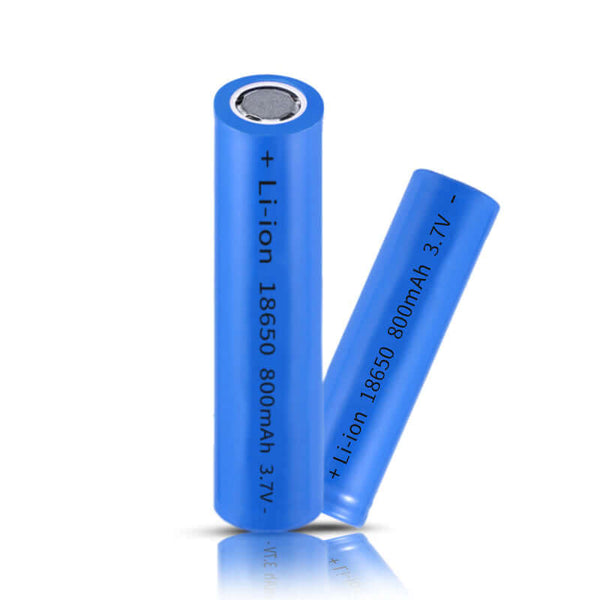In nature, lithium is the lightest metal with the smallest atomic mass. Its atomic weight is 6.94g/mol and ρ=0.53g/cm3. Lithium is chemically active and easily loses electrons and is oxidized to Li+. Therefore, the standard electrode potential is the most negative, -3.045V, and the electrochemical equivalent is the smallest, 0.26g/Ah. These characteristics of lithium determine that it is a very Materials with high specific energy. Ternary lithium battery refers to a lithium secondary battery that uses three transition metal oxides of nickel, cobalt and manganese as the positive electrode material. It fully integrates the good cycle performance of lithium cobalt oxide, the high specific capacity of lithium nickelate and the high safety and low cost of lithium manganate. It uses molecular level mixing, doping, coating and surface modification methods to synthesize nickel. Cobalt, manganese and other multi-element synergistic composite lithium intercalation oxides. It is a lithium-ion rechargeable battery that is widely researched and applied.
Ternary lithium battery life
The so-called lithium battery life refers to that the capacity of the battery decays to 70% of the nominal capacity (the battery capacity at room temperature 25°C, standard atmospheric pressure, and discharged at 0.2C) after a period of time, which can be considered as the end of life. In the industry, the cycle life is generally calculated by the number of cycles of fully charged and discharged lithium batteries. In the process of use, an irreversible electrochemical reaction occurs inside the lithium battery, which leads to a decrease in capacity, such as the decomposition of electrolyte, the deactivation of active materials, the collapse of the positive and negative electrode structure, and the reduction in the number of lithium ions inserted and extracted, etc. . Experiments have shown that a higher rate of discharge will lead to a faster attenuation of capacity. If the discharge current is lower, the battery voltage will be close to the equilibrium voltage and more energy can be released.
The theoretical life of a ternary lithium battery is about 800 cycles, which is medium among commercial rechargeable lithium batteries. Lithium iron phosphate is about 2,000 cycles, while lithium titanate is said to be able to reach 10,000 cycles. At present, mainstream battery manufacturers promise more than 500 times (charge and discharge under standard conditions) in the specifications of their ternary batteries. However, after the batteries are assembled into a battery pack, due to consistency issues, the main voltage and internal The resistance cannot be exactly the same, and its cycle life is about 400 times. The manufacturer recommends that the SOC use window is 10%~90%. Deep charging and discharging is not recommended, otherwise it will cause irreversible damage to the positive and negative structure of the battery. If it is calculated by shallow charge and shallow discharge, the cycle life will be at least 1000 times. In addition, if lithium batteries are frequently discharged under high-rate and high-temperature environments, the battery life will be drastically reduced to less than 200 times.
Advantages and disadvantages of ternary lithium battery
The ternary lithium battery is relatively balanced in terms of capacity and safety, and is a battery with excellent overall performance. The main functions, advantages and disadvantages of the three metal elements are as follows:
Co3+: Reduce the cation mixing space, stabilize the layered structure of the material, reduce the impedance value, increase the electrical conductivity, and improve the cycle and rate performance.
Ni2+: can increase the capacity of the material (increase the volume energy density of the material), and due to the similar radius of Li and Ni, too much Ni will also cause lithium and nickel to be mixed due to the dislocation phenomenon of Li, and the concentration of nickel ions in the lithium layer The larger the value, the more difficult it is to deintercalate lithium in the layered structure, resulting in poor electrochemical performance.
Mn4+: Not only can reduce the cost of materials, but also can improve the safety and stability of the materials. However, an excessively high Mn content will easily form a spinel phase and destroy the layered structure, reducing the capacity and reducing the cycle.
High energy density is the biggest advantage of ternary lithium batteries, and the voltage platform is an important indicator of battery energy density, which determines the basic efficiency and cost of the battery. The higher the voltage platform, the larger the specific capacity, so the same volume, weight, and even the same Ampere’s battery, the ternary material lithium battery with a higher voltage platform has a longer battery life. The discharge voltage platform of the single ternary lithium battery is as high as 3.7V, the lithium iron phosphate is 3.2V, and the lithium titanate is only 2.3V. Therefore, from the perspective of energy density, the ternary lithium battery is higher than lithium iron phosphate, lithium manganate or Lithium titanate has absolute advantages.
Poor safety and short cycle life are the main shortcomings of ternary lithium batteries, especially safety performance, which has been a major factor that has restricted their large-scale matching and large-scale integrated applications. A large number of actual tests have shown that it is difficult for ternary batteries with larger capacity to pass safety tests such as acupuncture and overcharge. This is also the reason why more manganese elements are generally introduced in large-capacity batteries, or even mixed with lithium manganate. The cycle life of 500 times is in the middle of the lithium battery, so the main application field of the ternary lithium battery is consumer electronic products such as 3C digital.
To learn more about Li-ion batteries, please refer to https://www.junleepower.com/


